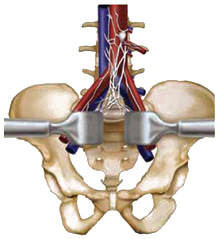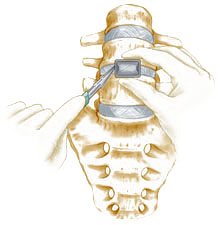Anterior Lumbar Interbody Fusion (ALIF)

Anterior lumbar interbody fusion (ALIF) is a spine surgery that involves approaching the spine from the front of the body to remove disc or bone material from in between two adjacent lumbar vertebrae. The disc material is then replaced by a block bone graft, or more usually by a titanium or PEEK plastic cage containing bone graft or bone morphogenetic protein.
The cage(s) or block graft act to maintain normal disc height - as the bone graft fuses with the bone of the vertebrae above and below to stabilize the spine. Instrumentation, such as rods, screws, plates, cages, hooks and wire also may be used to stop movement between the vertebrae in order to promote firm bony fusion.
Why Might I Need This Procedure?
Anterior Lumbar Interbody Fusion may be recommended in cases of:
- Acute herniation of the L5/S1 disc
- Chronic degeneration of the L5/S1 disc, with pain from abnormally loaded/degenerate facte joints behind
- As part of a "Hybrid operation" in which an artificial disc is implanted at one of the lower three levels in lumbar spine, with ALIF fusion(s) performed at one or both of the other two levels.

Less commonly Dr. Brazenor may recommend ALIF at one or more levels in lumbar spine if there has been extensive surgery to your spine from the posterior approach resulting in gross scarring around your nerve roots. In such cases it may be much safer for the "salvage" operation to be performed from the front as ALIF(s).
Dr. Brazenor will take a number of factors into consideration before recommending an ALIF, including the condition to be treated, your age, health and lifestyle and your anticipated level of activity following surgery.
Dr. Brazenor will always explain your non-surgical option (if there is one) as well as the surgical option along with its success rate, failure rate and risks. Except when cancer or dangerous spinal instability is present, it is always Dr. Brazenor's advice that if you are then not sure about having surgery, you should choose not to have surgery for the moment. Stop, think, and let some time pass, and the correct way for you to manage your condition will become clear.
How Is An ALIF Performed?
For an ALIF procedure, the patient is positioned on his or her back and put to sleep under general anaesthesia. The surgeon then
- Makes an incision in the abdomen and retracts the abdominal muscles, organs and vascular structures - including such major blood vessels as the aorta and vena cava - for a clear view of the front of the spine and access to the vertebrae.
- Removes all or part of the degenerated disc(s) from the affected disc space, and inserts bone graft or cage(s) into the disc space between the vertebral bodies, to support the disc space and promote bone healing. He may then add instrumentation composed of screws or plates to stabilise the spine during the 6-12 months which it takes for the bone graft to fuse.
- Returns the abdominal organs, blood vessels and muscles to their normal place, and closes the incision..

How Long Will It Take Me To Recover?
Your surgeon will advise you in detail on the post-operative recovery/exercise plan to help you return to your normal activity level as soon as possible. The amount of time that you have to stay in the hospital will depend on this treatment plan. You typically will be up and walking in the hospital by the end of the first or second day after the surgery. You may return to work in 3-6 weeks, depending on how well your body is healing and the type of work/activity level you plan to return to.
Dr. Brazenor will advise you in general terms about your likely postoperative course, but will stress that your final surgical expectations must come from the surgeon or surgeons to whom he refers you. Dr. Brazenor's pledge is that he will only refer you to surgeons whom he knows are capable of expertly doing the operation you need.
Are There Any Potential Risks Or Complications?
Any surgery and anaesthesia can result in injury or even, rarely, death. One only has to read the newspaper to confirm that fact. Complications such as infection, nerve damage, blood clots, blood loss and bowel and bladder problems, along with complications associated with anaesthesia, are some of the potential risks of spinal surgery. A potential risk inherent to spinal fusion is failure of the vertebral bone and graft to properly fuse, a condition that may require additional surgery.
